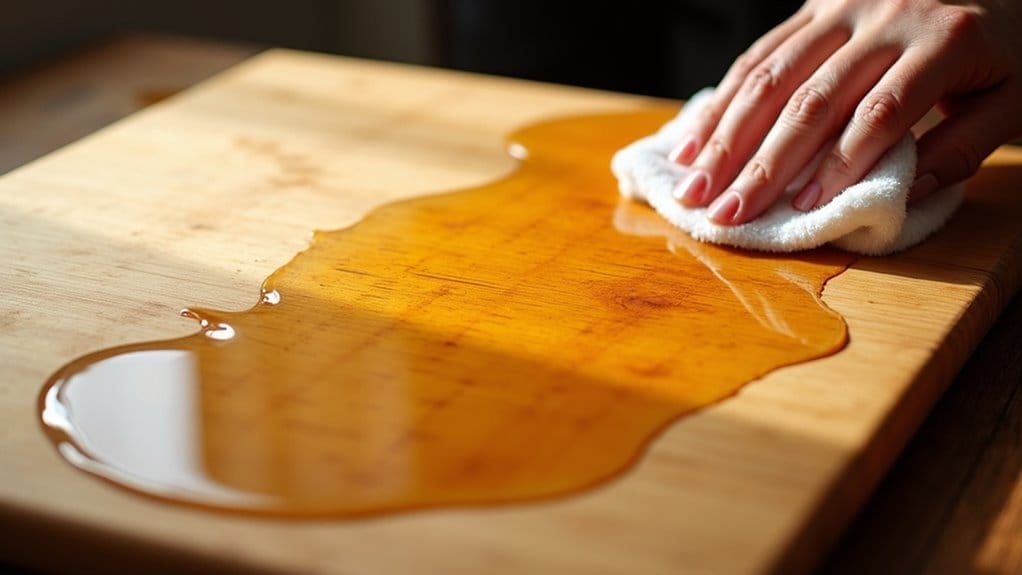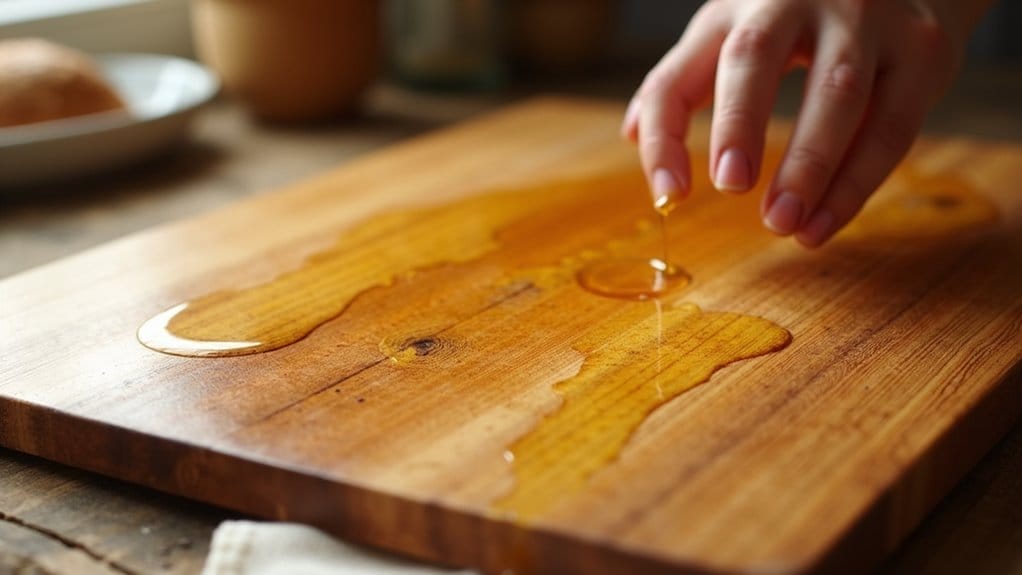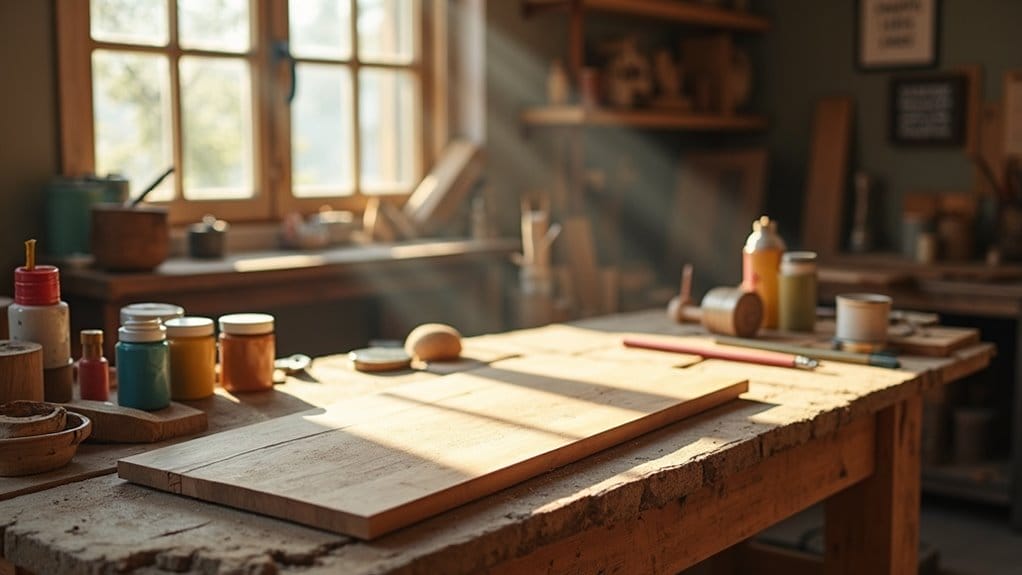You’ll need more than just soap and water to keep your wood cutting board in prime condition. While daily cleaning is essential, proper seasoning is what prevents your board from warping, cracking, or harboring harmful bacteria. Whether you’ve invested in a high-end maple board or cherish your grandmother’s vintage butcher block, understanding the art of seasoning will protect your investment and extend its lifespan for years to come. Let’s explore the complete process of maintaining this essential kitchen tool.
Key Takeaways
- Clean the board thoroughly with warm soapy water and dry completely before applying food-grade mineral oil or coconut oil.
- Apply oil generously in the direction of wood grain, letting it soak for 4-6 hours before wiping excess.
- Re-season every 4-6 weeks or when surface appears dry, applying multiple coats for maximum protection.
- Store the board vertically in a cool, dry place away from direct sunlight to ensure proper air circulation.
- Perform monthly water droplet tests to check for dry spots and inspect weekly for signs of wear.
Importance of Seasoning a Wood Cutting Board

You’ll protect your wooden cutting board from moisture damage, warping, and bacterial growth by properly seasoning it with food-grade oil.
The oil penetrates deep into the wood’s fibers, creating a protective barrier that prevents water absorption while maintaining the board’s natural antimicrobial properties.
Regular seasoning extends your board’s lifespan and enhances its performance by keeping the surface smooth and knife-friendly.
Benefits of Properly Seasoning a Wood Board
A properly seasoned wood cutting board offers multiple essential benefits that directly impact its longevity and performance.
Regular seasoning creates a protective finish that prevents your board from absorbing harmful bacteria and food odors. You’ll reinforce the wood’s natural structure, reducing the risk of warping and cracking over time.
Quality maintenance through proper seasoning also helps your board resist stains and maintain its aesthetic appeal. The oil treatment penetrates deep into the wood’s fibers, creating a barrier against moisture while keeping the surface smooth for easier cleaning and safer food preparation.
Why You Should Use Oil for Seasoning
When wood cutting boards are left untreated, they become vulnerable to moisture absorption, which can lead to warping, cracking, and bacterial growth.
That’s why you’ll need to season your board regularly with food grade oil. The oil creates a protective barrier that prevents moisture from seeping into the wood’s fibers while maintaining the board’s natural properties.
- Oil penetrates deep into the wood grain, creating a lasting moisture barrier
- Regular seasoning prevents the wood from drying out and splitting
- Food-safe oils help maintain the board’s natural antimicrobial properties
- Proper oiling guarantees your board won’t absorb food odors or stains
How to Properly Season a Wood Cutting Board

Before you begin seasoning your wood cutting board, make certain it’s thoroughly cleaned and completely dry, as any moisture can interfere with the oil absorption process.
You’ll need to select a food-grade mineral oil or coconut oil specifically designed for wood cutting boards, avoiding cooking oils that can turn rancid over time.
Start by applying a generous amount of your chosen oil in the direction of the wood grain, allow it to soak for at least 4-6 hours, and then wipe off any excess oil with a clean cloth.
Repeat this process several times for maximum protection. With these easy steps, you can take care of your cutting board.
Step 1: Clean the Cutting Board
Proper cleaning serves as the essential first step in seasoning your wooden cutting board.
Begin by washing the surface of your board with warm, soapy water to remove any debris, oils, or residue. Thoroughly rinse and immediately dry with a clean towel to prevent excess moisture absorption.
Allow the board to air dry completely for at least 2 hours before proceeding with seasoning.
- Use mild dish soap to clean without stripping the wood’s natural properties
- Scrub gently along the grain to maintain the board’s integrity
- Avoid soaking the board, as excessive water can cause warping
- Pat dry immediately with a lint-free towel to prevent water spots
Step 2: Choose the Right Oil for Seasoning
Selecting the right oil stands as an essential factor in effectively seasoning your wooden cutting board. Different oil options for wood cutting boards, such as mineral oil, tung oil, and walnut oil, each provide unique benefits and protection for the surface. It’s important to choose an oil that penetrates well, helping to prevent moisture absorption and maintain the board’s integrity. Regularly applying the right oil not only enhances the wood’s appearance but also extends its lifespan, ensuring a reliable kitchen tool for years to come.
You’ll want to avoid cooking oils that can turn rancid, like olive or vegetable oil. Instead, opt for food-grade mineral oil, which won’t spoil and helps protect your board from moisture.
For enhanced protection, consider using a combination of mineral oil for deep absorption and beeswax for sealing.
This dual approach creates a superior antibacterial barrier. You can also find specially formulated cutting board oils that combine both elements.
Apply the oil generously, allowing it to absorb fully before applying any additional wax coating.
Step 3: Apply Oil to the Wooden Cutting Board
The actual oil application process requires careful attention to detail and proper technique. When you apply oil to your wooden cutting board, work in thin layers following the direction of the grain.
Let each layer absorb fully before adding the next one, ensuring proper seasoning and maintenance of your board.
- Pour a small amount of oil onto the board’s surface and spread it evenly using circular motions.
- Apply firm pressure while rubbing to help the oil penetrate deeper into the wood fibers.
- Wait 4-6 hours between applications to allow complete absorption.
- Remove any excess oil with a clean cloth to prevent sticky residue.
Step 4: Let the Oil Soak In
After applying oil to your wooden cutting board, allowing sufficient absorption time becomes essential for best seasoning results.
Let your board rest for 4-6 hours in a clean, dry area away from direct sunlight. During this time, the wood will naturally absorb the oil into its grain. If you notice excess oil pooling on the surface, gently wipe it away with a clean cloth.
For optimal protection, you’ll want to apply additional coats once the first layer has fully soaked in. Test absorption by touching the surface – it should feel dry, not tacky, before applying the next coat.
Step 5: Wipe Off Excess Oil
Once your wooden cutting board has absorbed oil for 4-6 hours, you’ll need to remove any remaining surface oil to prevent tackiness and confirm proper seasoning.
Use a clean, lint-free cloth to wipe the surface in firm, deliberate strokes along the wood grain. This final step guarantees your cutting board develops an even, protective coating without leaving behind a greasy residue.
- Wipe in a single direction to avoid pushing excess oil back into areas you’ve already cleaned
- Test the surface by running your hand across it – it should feel smooth, not oily
- Pay special attention to the edges and corners where oil tends to collect
- Use a fresh section of cloth when the first becomes saturated with excess oil
Step 6: Seal and Maintain the Cutting Board
With your cutting board properly oiled and wiped clean, you’ll want to apply a protective seal to lock in the seasoning and provide additional defense against moisture. Apply a thin layer of food-grade beeswax using circular motions to protect the wood’s surface.
| Maintenance Task | Frequency | Purpose |
|---|---|---|
| Wax Coating | Monthly | Seal surface |
| Oil Treatment | Bi-monthly | Nourish wood |
| Water Test | Weekly | Check seal |
Let the wax absorb for 12 hours before use. Maintain this protective barrier by checking regularly for signs of wear. When water no longer beads on the surface, it’s time to reseal and maintain your board’s seasoning.
Tips for Maintaining Your Seasoned Wood Cutting Board

Your wooden cutting board’s longevity depends on consistent maintenance through regular oil applications and proper storage techniques.
You’ll need to reapply oil whenever the surface appears dry or dull, typically every 4-6 weeks for frequently used boards.
Store your board in a cool, dry place away from direct sunlight and heat sources, standing it vertically to allow proper air circulation and prevent warping.
Regularly Reapply Oil
Because wooden cutting boards naturally lose their protective oil barrier over time, maintaining a consistent oiling schedule is essential for long-term board health.
Regularly reapply oil to your board, observing how quickly the wood absorbs it. Proper maintenance requires attention to your board’s specific needs, as usage patterns affect oil absorption rates.
- Check monthly for dry spots by performing the water droplet test
- Apply oil when water no longer beads on the surface
- Focus on end-grain areas, which tend to absorb oil more quickly
- Allow each oil application to absorb fully before using the board
Store Your Cutting Board Correctly
Proper storage of a seasoned wooden cutting board plays an essential role in maintaining its longevity and performance.
After your board has fully absorbed the seasoning oil, store it in a cool, dry area of your kitchen away from direct heat sources and sunlight. Stand the board vertically to allow proper air circulation and prevent bacteria growth.
Don’t lay it flat on a counter where moisture can get trapped underneath. You’ll need to re-season your board more frequently if it’s exposed to high humidity.
Check your cutting board weekly for signs of wear and verify it’s stored correctly to extend time between maintenance sessions.
Frequently Asked Questions
Can I Use My Cutting Board Immediately After Seasoning It?
You’ll need to wait 4-6 hours after seasoning your cutting board before using it. This allows the oil to fully absorb into the wood fibers and guarantees you won’t transfer any excess oil to your food.
Will Olive Oil Go Rancid if Used for Seasoning?
Yes, you shouldn’t use olive oil for seasoning your cutting board. It’s high in unsaturated fats that will go rancid over time, causing unpleasant odors. Instead, use food-grade mineral oil or coconut oil for better results.
How Do I Remove Mold From My Wooden Cutting Board?
First, scrub your board with hot water and vinegar to kill mold. Then, sand the affected area with 220-grit sandpaper. Clean thoroughly, let it dry completely, and re-season with mineral oil immediately.
Should I Season Both Sides of the Cutting Board?
Yes, you’ll need to season both sides of your cutting board. This prevents warping and guarantees even moisture protection. Even if you don’t use both sides, complete saturation maintains the board’s structural integrity and longevity.
Can I Use Sandpaper Between Seasonings to Smooth Rough Spots?
Yes, you can use fine-grit sandpaper (220 or higher) between seasonings to smooth rough spots. After sanding, wipe away all dust with a damp cloth, let it dry completely, then proceed with your seasoning process.
Conclusion
Maintaining your wood cutting board isn’t complicated when you follow these essential steps. You’ll need to reapply mineral oil every 4-6 weeks, conduct regular water bead tests, and store your board vertically in a cool, dry space. By consistently following proper seasoning techniques and performing routine maintenance, you’ll protect your board’s surface, prevent warping, and guarantee it remains a reliable kitchen tool for years to come.






































